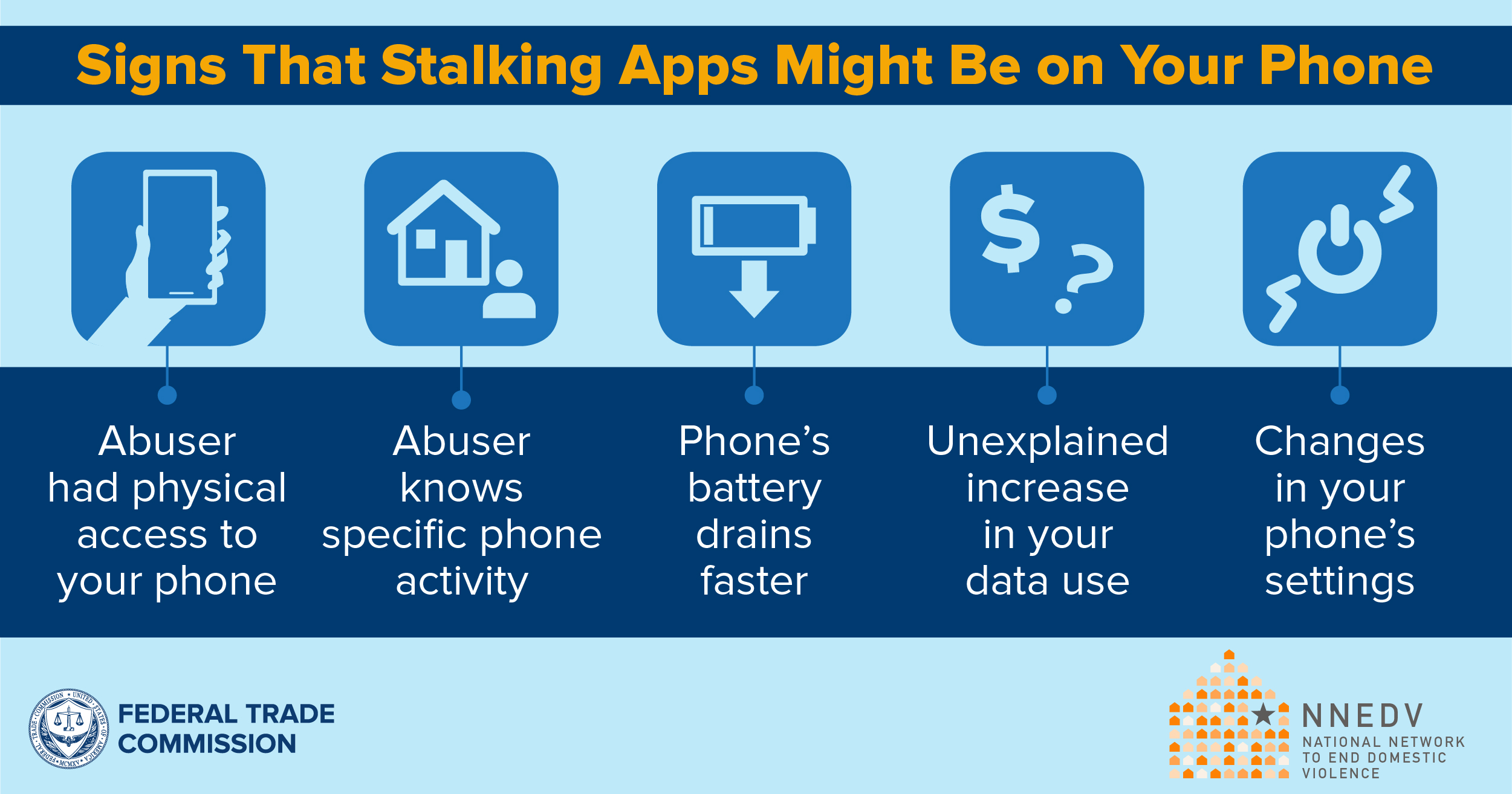Stalkerware Explained
An abusive partner or ex might install a stalkerware program or stalking app on your phone to secretly track or monitor you. Or they might gift you a phone that has stalkerware installed on it.
Stalkerware programs and apps have different capabilities. But if your phone has stalkerware on it, the abuser may be able to
- see your phone’s location
- see all the calls you’ve made and gotten
- record your phone conversations
- read your text messages and emails
- see the photos and videos you’ve taken
- see what you’re doing online
Some stalkerware also lets the abuser use your microphone and camera to see and hear what’s happening around the phone.
Signs That You May Have Stalkerware on Your Phone
Stalkerware developers do things to hide stalkerware apps, which make it hard for the phone’s owner to detect stalkerware. But there are some signs to look for:
- The abuser knows a lot of very specific information about you, like your exact location, the content of conversations you’ve had, what you’ve texted and to whom, and what you’ve searched for online.
- The abuser has or had physical access to your phone.
- Your phone’s battery drains faster than usual, without any difference in how you’ve been using your phone.
- There’s an unexplained increase in the amount of data you use.
- There are unexpected changes in your phone’s settings.

What To Do if You Think There’s Stalkerware on Your Phone
Remember that taking any of these steps could tip off your abuser — especially if you use your phone to research your options, make a call, or have a conversation near your phone. If you are concerned your phone might be monitored, consider leaving it behind when you are seeking help. Trust your instincts and do what’s best in your particular situation.
If you think there’s stalkerware on your phone, here are some steps to consider:
Think about your safety first
An abuser who uses stalkerware to monitor you may escalate their abuse if they suspect you’re cutting off access. So, before you remove stalkerware, talk with a domestic violence advocate about safety planning.
Get help
A domestic violence advocate can also help you identify tech misuse and talk to you about preserving evidence of abuse before you make changes to your phone. Because stalkerware can be hard to detect, you may need to get help from a law enforcement official if that’s an option you’re comfortable with.
If you choose to contact a domestic violence advocate or law enforcement official, contact them from a device different from the one that might have the stalkerware, like a friend or family member’s device, or a computer at the library, if possible.
Check if your phone’s been “rooted” or “jailbroken”
Some stalkerware apps can only be installed on a phone that’s been “rooted” or “jailbroken,” which gives a person full control over the phone’s operating system.
Root checker apps can quickly tell you whether a phone has been rooted or jailbroken. But if there is stalkerware on the device, the abusive person may see this activity.
If you find that your phone has not been rooted or jailbroken, but the person knows more than they should about your phone or online activities, they may be getting that information by accessing your phone or logging in to your accounts without your knowledge.
Replace or reset your phone
It might be safest to get a new phone with an account the abuser doesn’t have access to. If you decide to keep your phone, consider doing a full factory reset of the device, which may remove the stalkerware.
Before replacing or resetting your phone, take steps to document evidence of abuse, or preserve valuable content you may want to keep, like photos.
Whether you get a new phone or reset your phone, don’t reinstall programs from a backup of the old phone. This could reinstall the stalkerware.
Safety Tips if You’re Concerned About Stalkerware
An abuser can install stalkerware in just a few minutes. Here are some ways to make it more difficult for them to do so.
Always know where your phone is
- Be careful if someone wants to update or fix something on your phone.
- Beware of gifts to you or your children of a new smartphone or tablet because it could have stalkerware on it.
Lockdown your phone
- Set your phone to lock immediately when you’re not using it.
- Create a passcode or a PIN to unlock your phone. Choose something that’s hard for your abuser to guess. And don’t share it.
- Use an anti-malware program that can detect and remove stalkerware.
- Update your phone. Those updates often include critical patches and protections against security threats.
Lockdown your accounts
- If your abuser has access to your accounts, like your social media and email, they could use those to track you. Consider changing your account passwords. Create a strong password that’s hard to guess. A password manager can help you create and remember passwords.
- Use multi-factor authentication (MFA) for an additional level of account security. With MFA, you’ll have to enter your password and something else to log in. That could be a PIN, the answer to a security question, or a one-time verification code you get by text, email, or from an authenticator app.
More Resources for Survivors
Organizations like the National Network to End Domestic Violence and the National Domestic Violence Hotline have helpful resources.
National Network to End Domestic Violence
- Seeking Help: National Resources & Safety and Privacy Tips for Survivors
- Technology Safety & Privacy: A Toolkit for Survivors
National Domestic Violence Hotline
